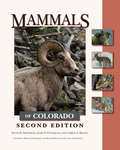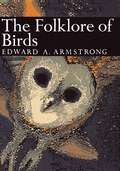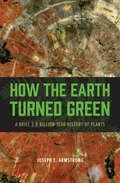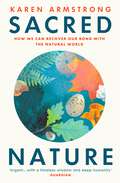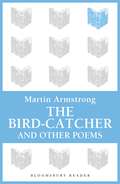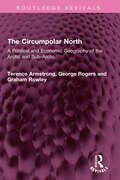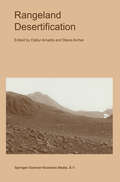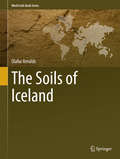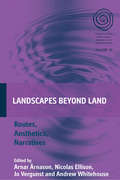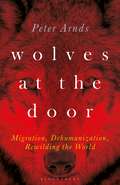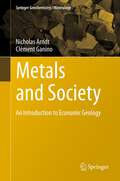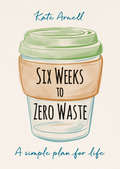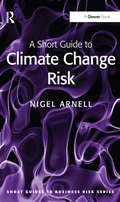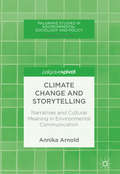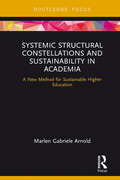- Table View
- List View
Mammals of Colorado, Second Edition
by David M. Armstrong James P. Fitzgerald Carron A. MeaneyThoroughly revised and updated, Mammals of Colorado, Second Edition is a comprehensive reference on the nine orders and 128 species of Colorado's recent native fauna, detailing each species' description, habitat, distribution, population ecology, diet and foraging, predators and parasites, behavior, reproduction and development, and population status. An introductory chapter on Colorado's environments, a discussion of the development of the fauna over geologic time, and a brief history of human knowledge of Coloradan mammals provide ecological and evolutionary context. The most recent records of the state's diverse species, rich illustrations (including detailed maps, skull drawings, and photographs), and an extensive bibliography make this book a must-have reference. Amateur and professional naturalists, students, vertebrate biologists, and ecologists as well as those involved in conservation and wildlife management in Colorado will find value in this comprehensive volume. Co-published with the Denver Museum of Nature & Science
The Folklore of Birds: An Enquiry Into The Origin & Distribution Of Some Magico-religious Traditions (Collins New Naturalist Library #39)
by Edward A. ArmstrongTracing the magico-religious beliefs surrounding birds as far back in time as is possible, to the cultures in which these beliefs arose. This edition is exclusive to newnaturalists.com
How the Earth Turned Green: A Brief 3.8-Billion-Year History of Plants
by Joseph E. ArmstrongOn this blue planet, long before pterodactyls took to the skies and tyrannosaurs prowled the continents, tiny green organisms populated the ancient oceans. Fossil and phylogenetic evidence suggests that chlorophyll, the green pigment responsible for coloring these organisms, has been in existence for some 85% of Earth’s long history—that is, for roughly 3.5 billion years. In How the Earth Turned Green, Joseph E. Armstrong traces the history of these verdant organisms, which many would call plants, from their ancient beginnings to the diversity of green life that inhabits the Earth today. Using an evolutionary framework, How the Earth Turned Green addresses questions such as: Should all green organisms be considered plants? Why do these organisms look the way they do? How are they related to one another and to other chlorophyll-free organisms? How do they reproduce? How have they changed and diversified over time? And how has the presence of green organisms changed the Earth’s ecosystems? More engaging than a traditional textbook and displaying an astonishing breadth, How the Earth Turned Green will both delight and enlighten embryonic botanists and any student interested in the evolutionary history of plants.
How the Earth Turned Green: A Brief 3.8-Billion-Year History of Plants
by Joseph E. ArmstrongOn this blue planet, long before pterodactyls took to the skies and tyrannosaurs prowled the continents, tiny green organisms populated the ancient oceans. Fossil and phylogenetic evidence suggests that chlorophyll, the green pigment responsible for coloring these organisms, has been in existence for some 85% of Earth’s long history—that is, for roughly 3.5 billion years. In How the Earth Turned Green, Joseph E. Armstrong traces the history of these verdant organisms, which many would call plants, from their ancient beginnings to the diversity of green life that inhabits the Earth today. Using an evolutionary framework, How the Earth Turned Green addresses questions such as: Should all green organisms be considered plants? Why do these organisms look the way they do? How are they related to one another and to other chlorophyll-free organisms? How do they reproduce? How have they changed and diversified over time? And how has the presence of green organisms changed the Earth’s ecosystems? More engaging than a traditional textbook and displaying an astonishing breadth, How the Earth Turned Green will both delight and enlighten embryonic botanists and any student interested in the evolutionary history of plants.
How the Earth Turned Green: A Brief 3.8-Billion-Year History of Plants
by Joseph E. ArmstrongOn this blue planet, long before pterodactyls took to the skies and tyrannosaurs prowled the continents, tiny green organisms populated the ancient oceans. Fossil and phylogenetic evidence suggests that chlorophyll, the green pigment responsible for coloring these organisms, has been in existence for some 85% of Earth’s long history—that is, for roughly 3.5 billion years. In How the Earth Turned Green, Joseph E. Armstrong traces the history of these verdant organisms, which many would call plants, from their ancient beginnings to the diversity of green life that inhabits the Earth today. Using an evolutionary framework, How the Earth Turned Green addresses questions such as: Should all green organisms be considered plants? Why do these organisms look the way they do? How are they related to one another and to other chlorophyll-free organisms? How do they reproduce? How have they changed and diversified over time? And how has the presence of green organisms changed the Earth’s ecosystems? More engaging than a traditional textbook and displaying an astonishing breadth, How the Earth Turned Green will both delight and enlighten embryonic botanists and any student interested in the evolutionary history of plants.
How the Earth Turned Green: A Brief 3.8-Billion-Year History of Plants
by Joseph E. ArmstrongOn this blue planet, long before pterodactyls took to the skies and tyrannosaurs prowled the continents, tiny green organisms populated the ancient oceans. Fossil and phylogenetic evidence suggests that chlorophyll, the green pigment responsible for coloring these organisms, has been in existence for some 85% of Earth’s long history—that is, for roughly 3.5 billion years. In How the Earth Turned Green, Joseph E. Armstrong traces the history of these verdant organisms, which many would call plants, from their ancient beginnings to the diversity of green life that inhabits the Earth today. Using an evolutionary framework, How the Earth Turned Green addresses questions such as: Should all green organisms be considered plants? Why do these organisms look the way they do? How are they related to one another and to other chlorophyll-free organisms? How do they reproduce? How have they changed and diversified over time? And how has the presence of green organisms changed the Earth’s ecosystems? More engaging than a traditional textbook and displaying an astonishing breadth, How the Earth Turned Green will both delight and enlighten embryonic botanists and any student interested in the evolutionary history of plants.
How the Earth Turned Green: A Brief 3.8-Billion-Year History of Plants
by Joseph E. ArmstrongOn this blue planet, long before pterodactyls took to the skies and tyrannosaurs prowled the continents, tiny green organisms populated the ancient oceans. Fossil and phylogenetic evidence suggests that chlorophyll, the green pigment responsible for coloring these organisms, has been in existence for some 85% of Earth’s long history—that is, for roughly 3.5 billion years. In How the Earth Turned Green, Joseph E. Armstrong traces the history of these verdant organisms, which many would call plants, from their ancient beginnings to the diversity of green life that inhabits the Earth today. Using an evolutionary framework, How the Earth Turned Green addresses questions such as: Should all green organisms be considered plants? Why do these organisms look the way they do? How are they related to one another and to other chlorophyll-free organisms? How do they reproduce? How have they changed and diversified over time? And how has the presence of green organisms changed the Earth’s ecosystems? More engaging than a traditional textbook and displaying an astonishing breadth, How the Earth Turned Green will both delight and enlighten embryonic botanists and any student interested in the evolutionary history of plants.
How the Earth Turned Green: A Brief 3.8-Billion-Year History of Plants
by Joseph E. ArmstrongOn this blue planet, long before pterodactyls took to the skies and tyrannosaurs prowled the continents, tiny green organisms populated the ancient oceans. Fossil and phylogenetic evidence suggests that chlorophyll, the green pigment responsible for coloring these organisms, has been in existence for some 85% of Earth’s long history—that is, for roughly 3.5 billion years. In How the Earth Turned Green, Joseph E. Armstrong traces the history of these verdant organisms, which many would call plants, from their ancient beginnings to the diversity of green life that inhabits the Earth today. Using an evolutionary framework, How the Earth Turned Green addresses questions such as: Should all green organisms be considered plants? Why do these organisms look the way they do? How are they related to one another and to other chlorophyll-free organisms? How do they reproduce? How have they changed and diversified over time? And how has the presence of green organisms changed the Earth’s ecosystems? More engaging than a traditional textbook and displaying an astonishing breadth, How the Earth Turned Green will both delight and enlighten embryonic botanists and any student interested in the evolutionary history of plants.
Sacred Nature: How we can recover our bond with the natural world
by Karen Armstrong'KAREN ARMSTRONG IS A GENIUS' - A.N. Wilson, author of The Victorians and Winnie and WolfIn this hugely powerful book, Karen Armstrong argues that if we want to avert environmental catastrophe, it is not enough to change our behaviour: we need to learn to think and feel differently about the natural world - to rekindle our spiritual bond with nature. For most of human history, and in almost all the world's cultures, nature was believed to be sacred, and our God or gods to be present everywhere in the natural world. When people in the West began to separate God and nature in modern times, it was not just a profound breach with thousands of years of accumulated wisdom: it also set in train the destruction of the natural world.Taking themes that have been central to the world's religious traditions - from gratitude and compassion to sacrifice and non-violence - Armstrong offers practical steps to help us develop a new mindset to reconnect with nature and rekindle our sense of the sacred.Sacred Nature reveals the most profound connections between humans and the natural world. It speaks to anyone interested in our relationship with nature, worried about the destruction of our environment, and searching for new ways of thinking to shape the action needed to save our planet.'One of our best living writers on religion' Financial Times'Karen Armstrong is one of the handful of wise and supremely intelligent commentators on religion' Alain de Botton
The Bird-Catcher
by Martin ArmstrongThis beautiful collection of poems tells tales of blossoming springs and fruitful summers; in Honey Harvest Armstrong depicts Spring with the overweight apple blossom nodding on their branches and the sweet honey filling our shelves, and in Spanish Vintage we are almost able to taste the plump purple grapes of August as we follow their journey through the seasons, maturing in the dark bodegas ready to be sipped when the time is just right.This nature-inspired collection of poems was first published in 1929.
The Circumpolar North: A Political and Economic Geography of the Arctic and Sub-Arctic (Routledge Revivals)
by Terence Armstrong George Rogers Graham RowleyFirst Published in 1978, The Circumpolar North is designed for anyone with a more than superficial interest in the northern regions of our planet, geographical, economic, social, or political. The primary importance of North today is as a source of raw materials, as a world crossroads, and as a touchstone of the way nations behave towards their minority groups. Strategic considerations have led to the expenditure of vast sums of money; but world population expansion has not yet affected the northlands and their preservation in a natural state is still a feasible objective. The authors are experts in their own areas and have provided regional chapters on each of the land and ocean areas. The book compares the different approaches of the countries involved and deals also, in the context of the northern seas, with another political dimension – the relations between nations and their success in achieving international management of resources. This is an interesting read for scholars of geography, international relations and international economics.
The Circumpolar North: A Political and Economic Geography of the Arctic and Sub-Arctic (Routledge Revivals)
by Terence Armstrong George Rogers Graham RowleyFirst Published in 1978, The Circumpolar North is designed for anyone with a more than superficial interest in the northern regions of our planet, geographical, economic, social, or political. The primary importance of North today is as a source of raw materials, as a world crossroads, and as a touchstone of the way nations behave towards their minority groups. Strategic considerations have led to the expenditure of vast sums of money; but world population expansion has not yet affected the northlands and their preservation in a natural state is still a feasible objective. The authors are experts in their own areas and have provided regional chapters on each of the land and ocean areas. The book compares the different approaches of the countries involved and deals also, in the context of the northern seas, with another political dimension – the relations between nations and their success in achieving international management of resources. This is an interesting read for scholars of geography, international relations and international economics.
Rangeland Desertification (Advances in Vegetation Science #19)
by Olafur ArnaldsDesertification has occurred worldwide. The biophysical and socio-economic complexity of this phenomenon has challenged our ability to categorize, inventory, monitor and repair the condition of degraded lands. One of the most important distinctions to be made in relation to land degradation is between cultivated land used for annual crop production and `rangelands'. Grazing by free-roaming livestock is the traditional primary use of the world's rangelands. However, there is growing recognition of the importance of these vast acreages for wildlife habitat, hydrology and ground water recharge, recreation and aesthetics. This text focuses on the desertification of rangelands and explores processes, problems and solutions. Chapters in the first section evaluate interactions between `natural' and human-induced disturbance regimes, thresholds, and non-linear change with respect to vegetation, hydrology, nutrients and erosion. Chapters in the second section examine socio-economic constraints and approaches for preventing and reversing degradation. The book provides a contemporary, process-oriented perspective on rangeland degradation of value to students, policy-makers and professionals alike.
The Soils of Iceland (World Soils Book Series #9)
by Olafur ArnaldsIn this new volume in the World Soil series, the various types of Icelandic soils, their different characteristics, their formation, degradation and erosion are reviewed. At the same time, the book also deals with the agriculture and land use in general to give a complete view of Icelandic soils. The first part details the natural parameters such as the climate and the geography of Iceland. It also explains Icelandic geology, which is the major parameter controlling the soil formation in this country. The author describes the formation of Iceland, the main volcanic systems, central volcanoes, tephra production and its influence on the soils. Explanations on rocks, glaciers, rivers and other main geologic features are also given. The book continues with a description of the Icelandic geomorphology, giving insights on the main surface types, frost, cryoturbation and other cryogenic features. Then it details the different types of soils, their formation and main features, comparing the Icelandic soils to other soils elsewhere in the world. Erosion and land degradation are then reviewed, including the exceptionally active wind erosion and dust production. Finally, it gives an insight on land use, agriculture and vegetation types. All this accompanied by the most amazing photos to illustrate the great diversity of Icelandic Soil.
Landscapes Beyond Land: Routes, Aesthetics, Narratives (EASA Series #19)
by Arnar Árnason Nicolas Ellison Jo Vergunst Andrew WhitehouseLand is embedded in a multitude of material and cultural contexts, through which the human experience of landscape emerges. Ethnographers, with their participative methodologies, long-term co-residence, and concern with the quotidian aspects of the places where they work, are well positioned to describe landscapes in this fullest of senses. The contributors explore how landscapes become known primarily through movement and journeying rather than stasis. Working across four continents, they explain how landscapes are constituted and recollected in the stories people tell of their journeys through them, and how, in turn, these stories are embedded in landscaped forms.
Wolves at the Door: Migration, Dehumanization, Rewilding the World
by Peter ArndsIn view of the current rhetoric surrounding the global migrant crisis – with politicians comparing refugees with animals and media reports warning of migrants swarming like insects or trespassing like wolves – this timely study explores the cultural origins of the language and imagery of dehumanization. Situated at the junction of literature, politics, and ecocriticism, Wolves at the Door traces the history of the wolf metaphor in discussions of race, gender, colonialism, fascism, and ecology. How have 'Gypsies', Jews, Native Americans but also 'wayward' women been 'wolfed' in literature and politics? How has the wolf myth been exploited by Hitler, Mussolini and Turkish ultra-nationalism? How do right-wing politicians today exploit the reappearance of wolves in Central Europe in the context of the migration discourse? And while their reintroduction in places like Yellowstone has fuelled heated debates, what is the wolf's role in ecological rewilding and for the restoration of biodiversity? In today's fraught political climate, Wolves at the Door alerts readers to the links between stereotypical images, their cultural history, and their political consequences. It raises awareness about xenophobia and the dangers of nationalist idolatry, but also highlights how literature and the visual arts employ the wolf myth for alternative messages of tolerance and cultural diversity.
Wolves at the Door: Migration, Dehumanization, Rewilding the World
by Peter ArndsIn view of the current rhetoric surrounding the global migrant crisis – with politicians comparing refugees with animals and media reports warning of migrants swarming like insects or trespassing like wolves – this timely study explores the cultural origins of the language and imagery of dehumanization. Situated at the junction of literature, politics, and ecocriticism, Wolves at the Door traces the history of the wolf metaphor in discussions of race, gender, colonialism, fascism, and ecology. How have 'Gypsies', Jews, Native Americans but also 'wayward' women been 'wolfed' in literature and politics? How has the wolf myth been exploited by Hitler, Mussolini and Turkish ultra-nationalism? How do right-wing politicians today exploit the reappearance of wolves in Central Europe in the context of the migration discourse? And while their reintroduction in places like Yellowstone has fuelled heated debates, what is the wolf's role in ecological rewilding and for the restoration of biodiversity? In today's fraught political climate, Wolves at the Door alerts readers to the links between stereotypical images, their cultural history, and their political consequences. It raises awareness about xenophobia and the dangers of nationalist idolatry, but also highlights how literature and the visual arts employ the wolf myth for alternative messages of tolerance and cultural diversity.
Metals and Society: An Introduction to Economic Geology (Springer Geochemistry/Mineralogy #2)
by Nicholas Arndt Clément GaninoIn the second edition Steve Kesler (University of Michigan) has been added as an author to rewrite some chapters. The motivation for this revised edition is to more intensively address economic issues that surround the exploitation of mineral resources. This emphasis gives the book a unique character. With these sections Metals and Society deals with issues that pervade much of current science reporting – the rate of exploitation of natural resources, the question of when or if these resources will be exhausted, the pollution and social disturbance that accompanies mining, the compromises and challenges that arise from the explosion of demand from China, India and other rapidly developing countries, and the moral issues that surround mining of metals in lesser developed countries for consumption in the “first-world” countries. With its dual character, the book will be useful as an introductory text for students in the earth sciences and a reference volume for students, teachers and researchers of geography, economics and the social sciences.
Six Weeks to Zero Waste: A simple plan for life
by Kate ArnellWe are in the midst of a worldwide waste epidemic, where the average person in the UK throws away their own body weight in rubbish every seven weeks. The figure looks even worse at national level with the UK producing more than 100 million tonnes of waste every year. We all know the importance of reducing our environmental footprint, but the prospect of going green can seem daunting. Six Weeks to Zero Waste is both an accessible and aspirational programme to eliminate waste - and it goes beyond plastic. In this book, TV presenter turned eco blogger, Kate Arnell, will help you on your path to rubbish-free living, with the principles of the 5 Rs (refuse, reduce, reuse, recycle and rot). From cutting down on food waste and decluttering, to making homemade health and beauty products, you'll soon be on your way to a zero-waste lifestyle.
A Short Guide to Climate Change Risk (Short Guides to Business Risk)
by Nigel ArnellClimate change poses a risk to business operations and to markets, and a poor business response to this risk can lead to reputational damage, or worse. At the same time, climate change can bring opportunities for some businesses. In this addition to Gower’s series of Short Guides to Business Risk, Professor Arnell, one of the world’s leading experts in the field, reviews this critical area of risk posed to businesses and other organisations by climate change and considers how they can respond to this threat. A Short Guide to Climate Change Risk focuses on the impacts and consequences of climate change rather than on business use of energy or business and 'sustainability' issues. The author examines the advantages and disadvantages of different approaches to addressing these risks, with international case study examples. With chapters on the nature, science and politics of climate change, on the assessment and management of climate change risks, and recommendations for incorporating climate change risks into a Company Risk Management System, this concise guide serves the needs of business students and practitioners across a wide range of sectors, public and private.
A Short Guide to Climate Change Risk (Short Guides to Business Risk)
by Nigel ArnellClimate change poses a risk to business operations and to markets, and a poor business response to this risk can lead to reputational damage, or worse. At the same time, climate change can bring opportunities for some businesses. In this addition to Gower’s series of Short Guides to Business Risk, Professor Arnell, one of the world’s leading experts in the field, reviews this critical area of risk posed to businesses and other organisations by climate change and considers how they can respond to this threat. A Short Guide to Climate Change Risk focuses on the impacts and consequences of climate change rather than on business use of energy or business and 'sustainability' issues. The author examines the advantages and disadvantages of different approaches to addressing these risks, with international case study examples. With chapters on the nature, science and politics of climate change, on the assessment and management of climate change risks, and recommendations for incorporating climate change risks into a Company Risk Management System, this concise guide serves the needs of business students and practitioners across a wide range of sectors, public and private.
Climate Change and Storytelling: Narratives and Cultural Meaning in Environmental Communication
by Annika ArnoldClimate change is as much a cultural phenomenon as it is a natural one. This book is about those cultural patterns that surround our perception of the environmental crisis and which are embodied in the narratives told by climate change advocates. It investigates the themes and motifs in those narratives through the use of narrative theory and cultural sociology.Developing a framework for cultural narrative analysis, Climate Change and Storytelling draws on qualitative interviews with stakeholders, activists and politicians in the USA and Germany to identify motifs and the relationships between heroes, villains and victims, as told by the messengers of the narrative.This book will provide academics and practitioners with insights into the structure of climate change communication among climate advocates and the cultural fabric that informs it.
Climate Change and Storytelling: Narratives and Cultural Meaning in Environmental Communication
by Annika ArnoldClimate change is as much a cultural phenomenon as it is a natural one. This book is about those cultural patterns that surround our perception of the environmental crisis and which are embodied in the narratives told by climate change advocates. It investigates the themes and motifs in those narratives through the use of narrative theory and cultural sociology.Developing a framework for cultural narrative analysis, Climate Change and Storytelling draws on qualitative interviews with stakeholders, activists and politicians in the USA and Germany to identify motifs and the relationships between heroes, villains and victims, as told by the messengers of the narrative.This book will provide academics and practitioners with insights into the structure of climate change communication among climate advocates and the cultural fabric that informs it.
Systemic Structural Constellations and Sustainability in Academia: A New Method for Sustainable Higher Education
by Marlen ArnoldIn order to create truly sustainable universities, we require new methods of visualising and interpreting them holistically as institutions built on complex relationships and systems, rather than as individual departments and people operating independently. This book uses a systemic structural constellations approach to demonstrate how we can build more sustainable higher education institutions, both in terms of teaching and research and at an operational level. Drawing examples from current research and teaching, Systemic Structural Constellations and Sustainability in Academia explores how universities are not only centres of teaching and learning but can also play a crucial role in enabling future decision-makers to appreciate and contribute to a more sustainable future. Providing a clear introduction to systemic structural constellations and guidance on how to practically apply the theory to numerous aspects of the higher education system, this book will be of great interest to students and researchers of education for sustainable development, organisational learning and sustainable management, as well as those tasked with transforming the higher education system for the future.
Systemic Structural Constellations and Sustainability in Academia: A New Method for Sustainable Higher Education
by Marlen ArnoldIn order to create truly sustainable universities, we require new methods of visualising and interpreting them holistically as institutions built on complex relationships and systems, rather than as individual departments and people operating independently. This book uses a systemic structural constellations approach to demonstrate how we can build more sustainable higher education institutions, both in terms of teaching and research and at an operational level. Drawing examples from current research and teaching, Systemic Structural Constellations and Sustainability in Academia explores how universities are not only centres of teaching and learning but can also play a crucial role in enabling future decision-makers to appreciate and contribute to a more sustainable future. Providing a clear introduction to systemic structural constellations and guidance on how to practically apply the theory to numerous aspects of the higher education system, this book will be of great interest to students and researchers of education for sustainable development, organisational learning and sustainable management, as well as those tasked with transforming the higher education system for the future.
